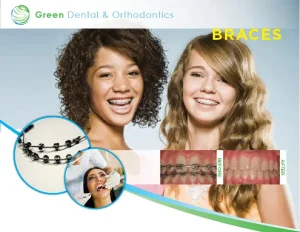Braces for Children

At Green Dental & Orthodontics, Shermak Oaks, we understand the importance of a confident smile for children. Our dedicated team of orthodontic experts specializes in providing exceptional braces treatment for children, helping them achieve healthy and beautiful smiles. With a focus on personalized care and cutting-edge techniques, we are committed to transforming smiles while ensuring a comfortable and positive experience for young patients.
There are a few reasons why children are ambivalent about getting braces. First, children don’t really think about how their teeth look and they’re worried about how other people will see them. Second, most children think that orthodontic braces treatment would be a painful experience. The truth is that the placement of orthodontic braces is not at all painful. In fact, many patients even describe the experience of getting braces as ‘fun’.
Investing in your child’s dental health is a decision that can positively impact their future. Child braces play a vital role in not only correcting misaligned teeth and bites but also in boosting their confidence.
Early orthodontic treatment is crucial for children as they are highly responsive to dental interventions during this stage. The AAO (American Association of Orthodontists) also suggests that children should have their first orthodontic visit around the age of seven. This early evaluation allows orthodontists to identify and address potential dental concerns promptly. By taking proactive measures, parents can lay the foundation for their child’s long-term dental health, preventing more complex and severe dental issues that may arise in the future. Early intervention paves the way for a lifetime of healthy smiles and sets children up for optimal oral well-being as they grow.
What Causes misalignment of teeth?
Misalignment happens when your teeth don’t meet properly because of the way your jaw is structured. Misalignment can be caused by an injury or it could be caused by teeth grinding. It’s important to see your dentist so they can make adjustments to your bite and your bite alignment.
It’s important to remember that sometimes, irregularity in teeth is genetic or the result of developmental issues.
Conversely, some irregularities are acquired or greatly exacerbated by certain habits and behaviors such as:
- Mouth breathing
- Thumb or finger sucking
- Prolonged pacifier use
- Poor oral hygiene
- Poor nutrition
What’s involved when a child gets braces?
During the initial consultation, your orthodontist will take a close look at your child’s teeth, jaw, and facial structure in order to determine if there’s enough room in the mouth to straighten the teeth without any issues. It’s all about creating a healthy and confident smile!
During the examination, the orthodontist will start with a visual inspection of your child’s teeth. They may also take panoramic X-rays, study models (cool bite impressions!), and computer-generated images of the head and neck. These initial assessments are super important because they help the orthodontist figure out the best plan of action.
Sometimes, the orthodontist might suggest “fixed” braces for your child. These braces are great because they can’t be lost or forgotten like removable ones. They stay in place, which often means treatment can be completed more quickly. It’s like a superhero cape for your child’s teeth!
Now, let’s talk about removable appliances. These are less invasive and usually used to address specific issues in the mouth. Think of them as specialized tools for specific needs. The world of orthodontic appliances is vast, with many different types available for different types of treatment. It’s amazing how technology can help create beautiful smiles!
In a nutshell, your orthodontist will guide you and your child through the process, ensuring a comfortable and positive experience. Soon, your child will be rocking a confident smile they can be proud of!
Here is a brief overview of some of the main types of orthodontic appliances used on children:

- Fixed Braces: One of the most popular methods for straightening teeth is the use of braces which consist of brackets that are attached to each tooth and an archwire that connects the brackets. In short, braces are a system of brackets that are affixed to each individual tooth, and an archwire that connects them. These brackets can be made of metal, ceramic, or clear, more cosmetic materials.
- Retainers: Retainers are usually used for retaining alignment during the third phase of treatment. As soon as the original malocclusion has been treated with braces, it is essential that the teeth stay in their current alignment; otherwise, the teeth will slip back to their original misalignment. These appliances are usually worn at night or while chewing specific foods. They may be removable or fixed.
- Headgear: It’s like a superhero helmet for your child’s jaw! This cool device fits over your head and lower teeth. Its mission? To bring your lower jaw forward and fix those slanted jaws (anteroposterior jaws). How does it do that? Well, it uses some magic elastics that extend or contract, attached to the device. It’s important to wear the headgear for about 12-20 hours each day. Remember, wearing it as recommended is the key to achieving the awesome results it promises.
If you have any questions or concerns about children’s braces, visit our dental & orthodontics office today.
